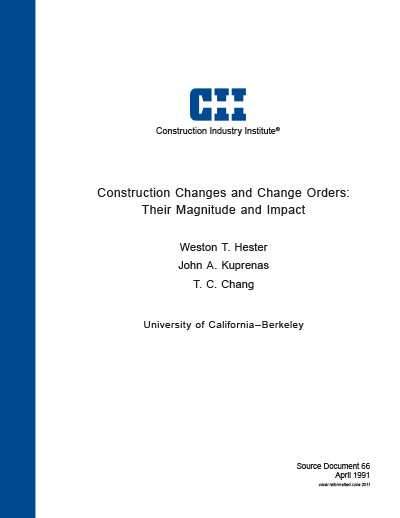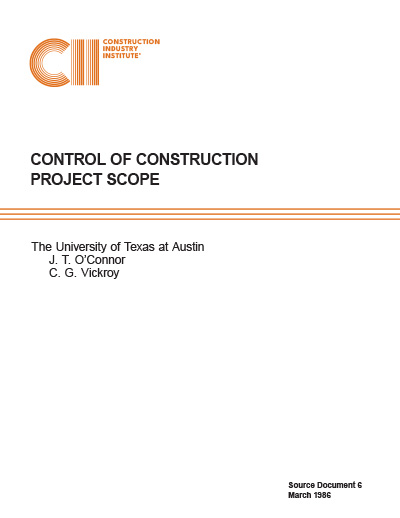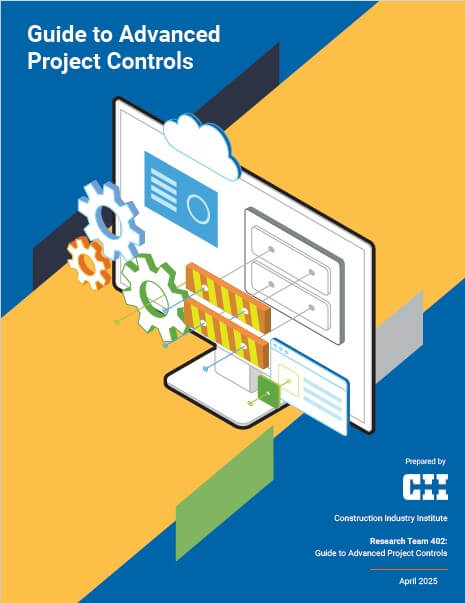
Construction Changes and Change Orders: Their Magnitude and Impact
The purpose of this report is to identify and discuss the real impact of changes on project costs and schedules. The legal basis for changes and their management is reviewed briefly, but the focus is on their management.
The report summarizes available literature on construction changes at the time of the research. But, the major contributions of this report are contained in Chapter 5 and Appendix B. Those sections provide specific data generated during field studies of the impact of changes and other factors on productivity, cost, and schedule, while also discussing techniques for effectively managing changes.
Terminology
A change is any event which results in a modification of the project work, schedule, or cost. Owners and designers frequently initiate changes during design development to reflect changes in project scope or preferences for equipment and materials other than those originally specified. Contractors often initiate changes when interferences are encountered, when designs are found to be not constructable, or other design errors are found.
The impact of a change is the net effect it has on the cost and schedule of work, and on the ability of project participants to manage and operate.
The Literature
Professional literature addressing the cost and schedule impact of changes may be grouped into four major categories—legal issues, specific cost and schedule impacts, analytical models for representing changes and their impacts, and methods for managing changes. Included in this study was a detailed search of the literature in each of these areas—an annotated bibliography is included as Appendix A to this report. Literature provides detailed discussions of the legal and management implications of changes, but there is little quantitative data on their sources and impact.
Case Studies
Several case studies are documented in the report. One, described in Chapter 5, compared productivity of workers performing a type task on the ground with productivity performing the same task in a high location. Surprisingly, the productivity in the elevated location was significantly better than that on the ground. Further study of this situation led to two conclusions: First, workers who will be working in a high or isolated environment plan their work better. Those on the ground plan less and thus waste time recovering from their lack of planning. Second, foremen are not likely to disturb or divert workers who are working in an isolated environment. On the other hand, they frequently disturb those that are close at hand.
Another study summarized in Chapter 5 involves the examination of worker productivity in the installation of piping. The productivity of these craft workers was tracked and compared under standard conditions and periods when an abnormal number of interruptions occurred. Data gathered shows that productivity quickly degenerates as the frequency of interruptions increases. Since changes are a form of interruption, one can logically conclude that productivity can be expected to degenerate as a consequence of frequent change introduction. Comparable data from another study is contained in Appendix B.
Other studies reported in Appendix B include one which tracked the effect of the ever-increasing frequency of change introduction on an industrial project. Data gathered revealed how significantly productivity can be affected as the frequency of change introduction increases. Another study on a different industrial project confirmed the trends revealed on the first study. Additional studies of the relationship of productivity to factors such as task type, task duration, and temperature are also reported.
It is concluded that the true impact of changes is not well understood and seldom fully recognized in terms of cost and schedule adjustment. It is recommended that change avoidance and control be given more attention by both owners and contractors.
Modification of scope is the single most common source of change on projects and market pressure for a product is the primary reason for poor project scope definition. Poor scope definition is the highest impact item that causes projects to run over budget. (SD-66, p. 10)



